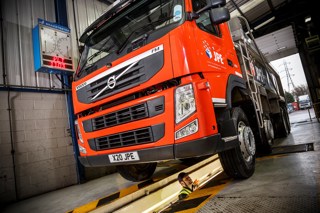A failure to deliver safe, secure rest areas and address shortcomings in the apprenticeship levy are damaging efforts to tackle the driver shortage, truck associations have warned.
In the UK, estimates suggest a shortfall of more than 50,000 qualified drivers, with the number of unfilled vacancies increasing by 50 each day.
Age is a major factor, with a quarter of the workforce due to retire in the next 10 years, thanks to the average UK driver age being in the 50s.
However, the cost of acquiring a HGV licence – some £3,000 – remains a major barrier for young people entering the profession, and poor parking facilities do nothing to improve their perception of the industry.
A Department for Transport (DfT) lorry parking survey, conducted a year ago, identified that there was an immediate need for more than 1,411 parking spaces to enable drivers to take their legally mandated rest breaks without concerns for security and safety. In the South East, it found 37% more overnight parking spaces were required immediately.
However, a year after former roads minister Jesse Norman made a commitment to increase parking places on the strategic road network, drivers believe the situation has actually deteriorated.
Almost all the respondents to a new Freight Transport Association (FTA) survey felt there had been no improvement in the facilities for drivers on local roads; more than half felt that the provision had become worse.
Elizabeth de Jong, FTA director of UK Policy, is calling for urgent action. “In an industry where you are compelled by law to take regular breaks and rest, it is vital that Government is pressing forward with its stated intention to improve and expand the provision of facilities,” she said.
“No other industry would be expected to operate in such conditions, and it is now down to Government to deliver on its promises.”
However, it’s not just a UK issue. The global industry association for road transport, the International Road Transport Union (IRU), says that rest areas across the whole of Europe are in desperate need of an upgrade.
Currently, Europe has only 300,000 truck parking spaces available and only a fraction of these guarantee basic service and security levels.
The IRU, which has been instrumental in helping the EU define a set of standards for rest areas, is calling for an additional 100,000 spaces and a decent place for drivers to rest.
It recently met with Europe’s transport commissioner, Violeta Bulc, to discuss the issue and hopes to tap into EU funding to kick-start much-needed change.
The IRU also says the high cost of training can put people off entering the profession and, like the FTA, believes changes to the apprenticeship levy could help deliver a boost in driver numbers.
Employers, with an annual salary bill of more than £3 million, must pay the levy, which in the current tax year is set at 0.5% of their total pay.
However, the training tax has been criticised for failing to deliver, including for the commercial fleet industry. In total, there were 375,800 apprenticeship starts in the 2017/18 financial year, down 26% on 2016/17.
A recent report from the Public Accounts Committee, which highlighted the scheme’s failings, blamed the Government’s focus on higher-level apprenticeships. It wants the scheme overhauled so more people benefit.
The FTA says its members are only claiming back a small proportion of the money they contribute under the levy, because the apprenticeships are not suited to their training needs.
FTA head of UK policy Christopher Snelling says he wants to see the apprenticeship levy turned into a training levy, so the commercial fleet industry can use funds to “deal with the skills shortage we face”.
Boris Blanche, managing director of the IRU, backs the FTA’s call for changes to the levy. He told Commercial Fleet: “We need to make sure we’re upskilling the UK workforce in as wide a way as possible that suits all business needs.”
The apprenticeships and skills minister, Anne Milton, said she would not “sacrifice quality for quantity”, but the Government was “considering” the Public Accounts Committee’s recommendations “carefully” and would respond in due course.
However, Hermes in partnership with employment and skills provider Seetec, says it has designed an apprenticeship which can help address the UK driver shortage.
The ‘Road to Logistics’ initiative, which is funded through the company’s apprenticeship levy, recruits LGV apprentices who currently have no driving experience, supporting them to achieve their Cat C and Cat C&E Licence.
The scheme is open to applicants of any age over 18, with the Level 2 apprenticeship taking 14 months. Successful participants will be offered roles as hub drivers at Warrington and Rugby.
Jenny Haynes, Hermes learning and development business partner, said a pilot scheme saw 14 new apprentice hub drivers recruited in April and it is now launching across its depots, revamping its old ‘Warehouse to Wheels’ programme.
Recruitment firm Manpower has also launched a ‘Driver Academy’ to help attract more young people into the profession.
It says its new training programme will halve the time it takes to complete an HGV qualification from an average of eight months to just four.
Jason Greaves, operations manager at Manpower, told Commercial Fleet: “We are hoping to have in excess of 4,000 job-ready graduates from the programme by the end of this year.”
The training costs from £2,000 to £3,000 (dependent on the level of the course undertaken), but Greaves said that there is the opportunity to apply for a payment plan to help with the finances.
However, he added: “Support in funding should be a top priority for the Government. The cost of training is still a deterrent for many potential candidates, but the opportunity to apply for grants to help with that could help encourage more to make that move.”






















Lee Jones - 03/02/2020 04:30
Wait till IR35 Tax rules kick in April 2020 and truck drivers that were actively advised by agencies to work through a limited company start losing an extra 20% on their weekly pay. Checking on the latest truck driver's pay and tax rates in Poland I'd be financially better off working over there after the changes. I can see a great number of Eastern European drivers returning home once they realise what IR35 actually means to their income. With the extra cost to the haulage and agency industries, I can see driver's pay rates also taking a hit so as to cut costs.